Nutritional and Physicochemical Properties of Wild Lingonberry (Vaccinium vitis-idaea L.)—Effects of Geographic Origin
Abstract
1. Introduction
2. Results and Discussion
3. Materials and Methods
3.1. Sample Preparation
3.2. Sample Preparation
3.3. Determination of Physicochemical Parameters
3.3.1. Measurement of pH and °Brix
3.3.2. Determination of Ascorbic Acid
3.3.3. Evaluation of Color in Lingonberries
3.4. Analysis
3.4.1. Determination of Total Phenolics Content (TPC)
3.4.2. HPLC Analysis of Total Anthocyanins Content (TAC)
3.4.3. Determination of Total Pro-Anthocyanidins Content (TPC)
3.4.4. Establishment of Ferric-Reducing Antioxidant Activity (FRAP)
3.4.5. Establishment of ABTS•+ Radical Scavenging Activity (ABTS RSA)
3.5. Statistical Analysis
4. Conclusions
Supplementary Materials
Author Contributions
Funding
Institutional Review Board Statement
Informed Consent Statement
Data Availability Statement
Conflicts of Interest
Sample Availability
References
- Jacobo-Velázquez, D.A.; Cisneros-Zevallos, L. An Alternative Use of Horticultural Crops: Stressed Plants as Biofactories of Bioactive Phenolic Compounds. Agriculture 2012, 2, 259–271. [Google Scholar] [CrossRef]
- Gustavsson, B.A. Genetic Variation in Horticulturally Important Traits of Fifteen Wild Lingonberry Vaccinium Vitis-Idaea L. Populations. Euphytica 2001, 120, 173–182. [Google Scholar] [CrossRef]
- Jang, M.H.; Piao, X.L.; Kim, J.M.; Kwon, S.W.; Park, J.H. Inhibition of Cholinesterase and Amyloid; Aggregation by Resveratrol Oligomers from Vitis Amurensis. Phyther. Res. 2008, 22, 544–549. [Google Scholar] [CrossRef] [PubMed]
- Cioch, M.; Satora, P.; Skotniczny, M.; Semik-Szczurak, D.; Tarko, T. Characterisation of Antimicrobial Properties of Extracts of Selected Medicinal Plants. Pol. J. Microbiol. 2017, 66, 463–472. [Google Scholar] [CrossRef]
- Cisowska, A.; Wojnicz, D.; Hendrich, A.B. Anthocyanins as Antimicrobial Agents of Natural Plant Origin. Nat. Prod. Commun. 2011, 6, 149–156. [Google Scholar] [CrossRef] [PubMed]
- Kowalska, K. Lingonberry (Vaccinium Vitis-idaea l.) Fruit as a Source of Bioactive Compounds with Health-promoting Effects—A Review. Int. J. Mol. Sci. 2021, 22, 5126. [Google Scholar] [CrossRef]
- Pomozova, V.A.; Shkrabtak, N.V.; Frolova, N.A. Use of V. Vitis-Idaea Berries and Extracts as Functional Basis for Food Production. AIP Conf. Proc. 2021, 2419, 020003. [Google Scholar] [CrossRef]
- Vilkickyte, G.; Raudone, L. Vaccinium Vitis-idaea l. Fruits: Chromatographic Analysis of Seasonal and Geographical Variation in Bioactive Compounds. Foods 2021, 10, 2243. [Google Scholar] [CrossRef]
- Ullah, A.; Munir, S.; Badshah, S.L.; Khan, N.; Ghani, L.; Poulson, B.G.; Emwas, A.H.; Jaremko, M. Important Flavonoids and Their Role as a Therapeutic Agent. Molecules 2020, 25, 5243. [Google Scholar] [CrossRef]
- Karasawa, M.M.G.; Mohan, C. Fruits as Prospective Reserves of Bioactive Compounds: A Review. Nat. Prod. Bioprospect. 2018, 8, 335–346. [Google Scholar] [CrossRef]
- Zeb, A. A Comprehensive Review on Different Classes of Polyphenolic Compounds Present in Edible Oils. Food Res. Int. 2021, 143, 110312. [Google Scholar] [CrossRef] [PubMed]
- United Nations, Department of Economic and Social Affairs, Population Division. World Population Prospects 2022: Summary of Results; UN DESA/POP/2022/TR/NO. 3; United Nations, Department of Economic and Social Affairs, Population Division: New York, NY, USA, 2022. [Google Scholar]
- Atella, V.; Piano Mortari, A.; Kopinska, J.; Belotti, F.; Lapi, F.; Cricelli, C.; Fontana, L. Trends in Age-Related Disease Burden and Healthcare Utilization. Aging Cell 2019, 18, e12861. [Google Scholar] [CrossRef]
- Dominguez, L.J.; Veronese, N.; Vernuccio, L.; Catanese, G.; Inzerillo, F.; Salemi, G.; Barbagallo, M. Nutrition, Physical Activity, and Other Lifestyle Factors in the Prevention of Cognitive Decline and Dementia. Nutrients 2021, 13, 4080. [Google Scholar] [CrossRef]
- Chopra, A.S.; Lordan, R.; Horbańczuk, O.K.; Atanasov, A.G.; Chopra, I.; Horbańczuk, J.O.; Jóźwik, A.; Huang, L.; Pirgozliev, V.; Banach, M.; et al. The Current Use and Evolving Landscape of Nutraceuticals. Pharmacol. Res. 2022, 175, 106001. [Google Scholar] [CrossRef] [PubMed]
- Dróżdż, P.; Šėžienė, V.; Wójcik, J.; Pyrzyńska, K. Evaluation of bioactive compounds, minerals and antioxidant activity of Lingonberry (Vaccinium vitis-idaea L.) fruits. Molecules 2018, 23, 53. [Google Scholar] [CrossRef]
- Georgieva, M.; Badjakov, I.; Dincheva, I.; Yancheva, S.; Kondakova, V. In Vitro Propagation of Wild Bulgarian Small Berry Fruits (Bilberry, Lingonberry, Raspberry and Strawberry). Bulg. J. Agric. Sci. 2016, 22, 46–51. [Google Scholar]
- Ștefănescu, B.E.; Călinoiu, L.F.; Ranga, F.; Fetea, F.; Mocan, A.; Vodnar, D.C.; Crișan, G. Chemical Composition and Biological Activities of the Nord-West Romanian Wild Bilberry (Vaccinium Myrtillus L.) and Lingonberry (Vaccinium Vitis- Idaea L.) Leaves. Antioxidants 2020, 9, 495. [Google Scholar] [CrossRef] [PubMed]
- Viljakainen, S.; Visti, A.; Laakso, S. Concentrations of organic acids and soluble sugars in juices from Nordic berries. Acta Agric. Scand. Sect. B-Plant Soil Sci. 2002, 52, 101–109. [Google Scholar] [CrossRef]
- Retamales, J.B.; Hancock, J.F. Blueberries; Crop Production Science in Horticulture Series; CABI Publ. Co.: Oxfordshire, UK, 2012; p. 336. [Google Scholar]
- Lee, J.; Finn, C.E. Lingonberry (Vaccinium vitis-idaea L.) grown in the Pacific Northwest of North America: Anthocyanin and free amino acid composition. J. Funct. Foods 2012, 4, 213–218. [Google Scholar] [CrossRef]
- Primetta, A.K.; Jaakola, L.; Ayaz, F.A.; Inceer, H.; Riihinen, K.R. Anthocyanin fingerprinting for authenticity studies of bilberry (Vaccinium myrtillus L.). Food Control 2013, 30, 662–667. [Google Scholar] [CrossRef]
- Vasco, C.; Ruales, J.; Kamal-Eldin, A. Total phenolic compounds and antioxidant capacities of major fruits from Ecuador. Food Chem. 2008, 111, 816–823. [Google Scholar] [CrossRef]
- Dincheva, I.; Badjakov, I. Assesment of the Anthocyanin Variation in Bulgarian Bilberry (Vaccinium Myrtillus L.) and Lingonberry (Vaccinium Vitis-Idaea L.). Int. J. Pharm. Sci. Res. 2016, 6, 39–45. [Google Scholar]
- Ieri, F.; Martini, S.; Innocenti, M.; Mulinacci, N. Phenolic Distribution in Liquid Preparations of Vaccinium myrtillus L. and Vaccinium vitis idaea L. Phytochem. Anal. 2013, 24, 467–475. [Google Scholar] [CrossRef]
- Hajazimi, E.; Landberg, R.; Zamaratskaia, G. Simultaneous determination of flavonols and phenolic acids by HPLC-CoulArray in berries common in the Nordic diet. LWT 2016, 74, 128–134. [Google Scholar] [CrossRef]
- Petruskevicius, A.; Viskelis, J.; Urbonaviciene, D.; Viskelis, P. Anthocyanin Accumulation in Berry Fruits and Their Antimicrobial and Antiviral Properties: An Overview. Horticulturae 2023, 9, 288. [Google Scholar] [CrossRef]
- Foley, S.L.; Debnath, S.C. Influence of in Vitro and Ex Vitro Propagation on Anthocyanin Content and Anti-Oxidant Activity of Lingonberries. J. Hortic. Sci. Biotechnol. 2007, 82, 114–118. [Google Scholar] [CrossRef]
- United States Pharmacopeia (USP). 31–NF 26 Second Supplement; Powdered Bilberry Extract (Identification and Assay); United States Pharmacopeia (USP): Rockville, MD, USA, 2008; p. 685. [Google Scholar]
- Stationery Office. European Pharmacopoeia, 6th ed.; Supplement 6.2; Fresh Bilberry Fruit Dry Extract Refined and Standardized; Stationery Office: London, UK, 2008; pp. 3745–3747. [Google Scholar]
- Kähkönen, M.P.; Heinämäki, J.; Ollilainen, V.; Heinonen, M. Berry anthocyanins: Isolation, identification and antioxidant activities. J. Sci. Food Agric. 2003, 83, 1403–1411. [Google Scholar] [CrossRef]
- Ek, S.; Kartimo, H.; Mattila, S.; Tolonen, A. Characterization of phenolic compounds from lingonberry (Vaccinium vitis-idaea). J. Agric. Food Chem. 2006, 54, 9834–9842. [Google Scholar] [CrossRef] [PubMed]
- Lehtonen, H.M.; Rantala, M.; Suomela, J.P.; Viitanen, M.; Kallio, H. Urinary excretion of the main anthocyanin in lingonberry (Vaccinium vitis-idaea), cyanidin 3-O-galactoside, and its metabolites. J. Agric. Food Chem. 2009, 57, 4447–4451. [Google Scholar] [CrossRef]
- Lätti, A.K.; Riihinen, K.R.; Jaakola, L. Phenolic compounds in berries and flowers of a natural hybrid between bilberry and lingonberry (Vaccinium × intermedium Ruthe). Phytochemistry 2011, 72, 810–815. [Google Scholar] [CrossRef]
- Bakowska-Barczak, A.M.; Marianchuk, M.; Kolodziejczyk, P. Survey of bioactive components in Western Canadian berries. Can. J. Physiol. Pharmacol. 2007, 85, 1139–1152. [Google Scholar] [CrossRef] [PubMed]
- Isaak, C.K.; Petkau, J.C.; Blewett, H.; Karmin, O.; Siow, Y.L. Lingonberry anthocyanins protect cardiac cells from oxidative-stress-induced apoptosis. Can. J. Physiol. Pharmacol. 2017, 95, 904–910. [Google Scholar] [CrossRef] [PubMed]
- Smeriglio, A.; Barreca, D.; Bellocco, E.; Trombetta, D. Proanthocyanidins and hydrolysable tannins: Occurrence, dietary intake and pharmacological effects. Br. J. Pharmacol. 2017, 174, 1244–1262. [Google Scholar] [CrossRef] [PubMed]
- Heil, M.; Baumann, B.; Andary, C.; Linsenmair, E.K.; McKey, D. Extraction and quantification of “condensed tannins” as a measure of plant anti-herbivore defence? Revisiting an old problem. Naturwissenschaften 2002, 89, 519–524. [Google Scholar] [CrossRef] [PubMed]
- Grace, M.H.; Esposito, D.; Dunlap, K.L.; Lila, M.A. Comparative analysis of phenolic content and profile, antioxidant capacity, and anti-inflammatory bioactivity in wild Alaskan and commercial Vaccinium berries. J. Agric. Food Chem. 2014, 62, 4007–4017. [Google Scholar] [CrossRef]
- Nestby, R.; Percival, D.; Martinussen, I.; Opstad, N.; Rohloff, J. The European blueberry (Vaccinium myrtillus L.) and the potential for cultivation. Eur. J. Plant Sci. Biotechnol. 2011, 5, 5–16. [Google Scholar]
- AOAC. Association of Official Analytical Chemists. Vitamins and other nutrients. In Official Methods of Analysis, 15th ed.; Helrich, K., Ed.; Association of Analytical Chemist Inc.: Washington, DC, USA, 1990. [Google Scholar]
- Bobinaitė, R.; Viškelis, P.; Venskutonis, P.R. Variation of total phenolics, anthocyanins, ellagic acid and radical scavenging capacity in various raspberry (Rubus spp.) cultivars. Food Chem. 2012, 132, 1495–1501. [Google Scholar] [CrossRef]
- Urbonaviciene, D.; Bobinaite, R.; Viskelis, P.; Bobinas, C.; Petruskevicius, A.; Klavins, L.; Viskelis, J. Geographic variability of biologically active compounds, antioxidant activity and physico-chemical properties in wild Bilberries (Vaccinium myrtillus L.). Antioxidants 2022, 11, 588. [Google Scholar] [CrossRef]
- Benzie, I.F.; Strain, J.J. The ferric reducing ability of plasma (FRAP) as a measure of “antioxidant power”: The FRAP assay. Anal. Biochem. 1996, 239, 70–76. [Google Scholar] [CrossRef]
- Bobinaitė, R.; Pataro, G.; Lamanauskas, N.; Šatkauskas, S.; Viškelis, P.; Ferrari, G. Application of pulsed electric field in the production of juice and extraction of bioactive compounds from blueberry fruits and their by-products. J. Food Sci. Technol. 2015, 52, 5898–5905. [Google Scholar] [CrossRef]
- Re, R.; Pellegrini, N.; Proteggente, A.; Pannala, A.; Yang, M.; Rice-Evans, C. Antioxidant activity applying an improved ABTS radical cation decolorization assay. Free Radic. Biol. Med. 1999, 26, 1231–1237. [Google Scholar] [CrossRef] [PubMed]

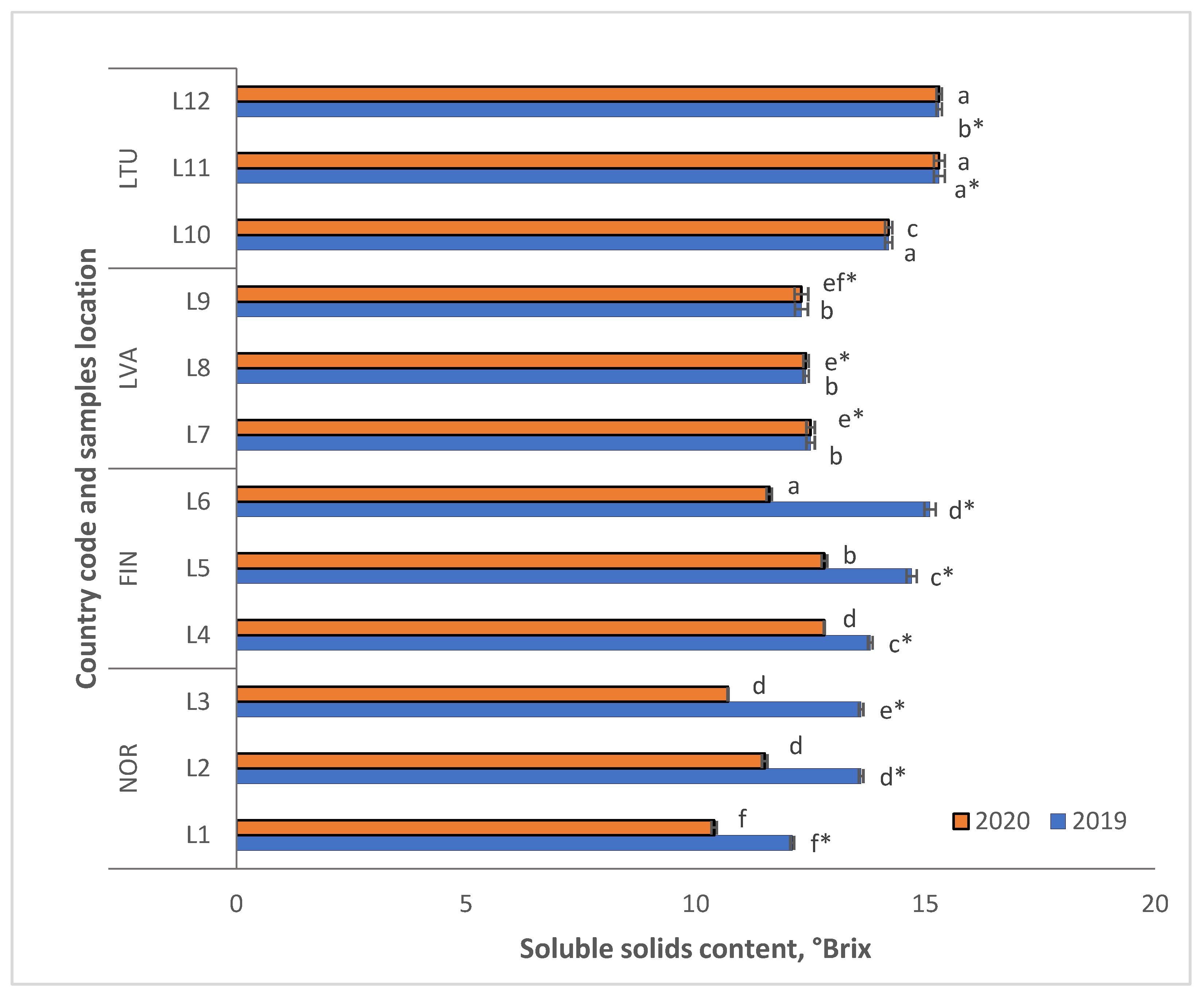
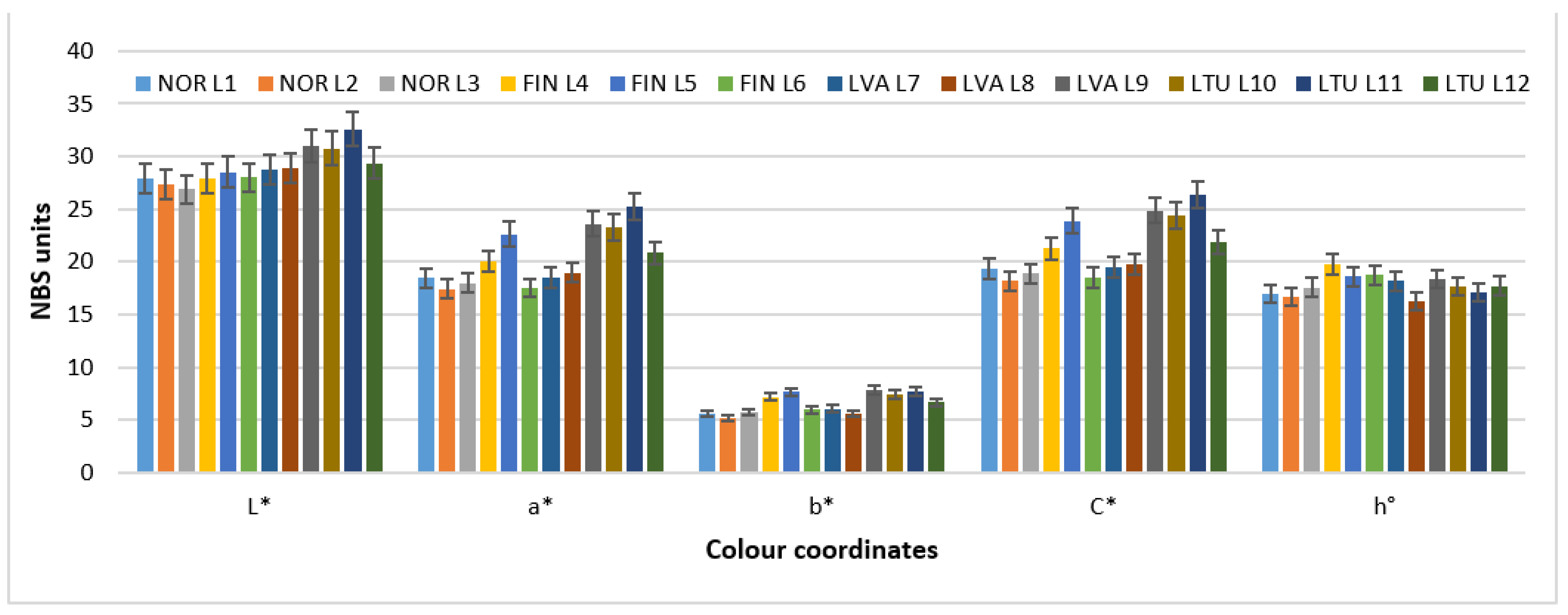
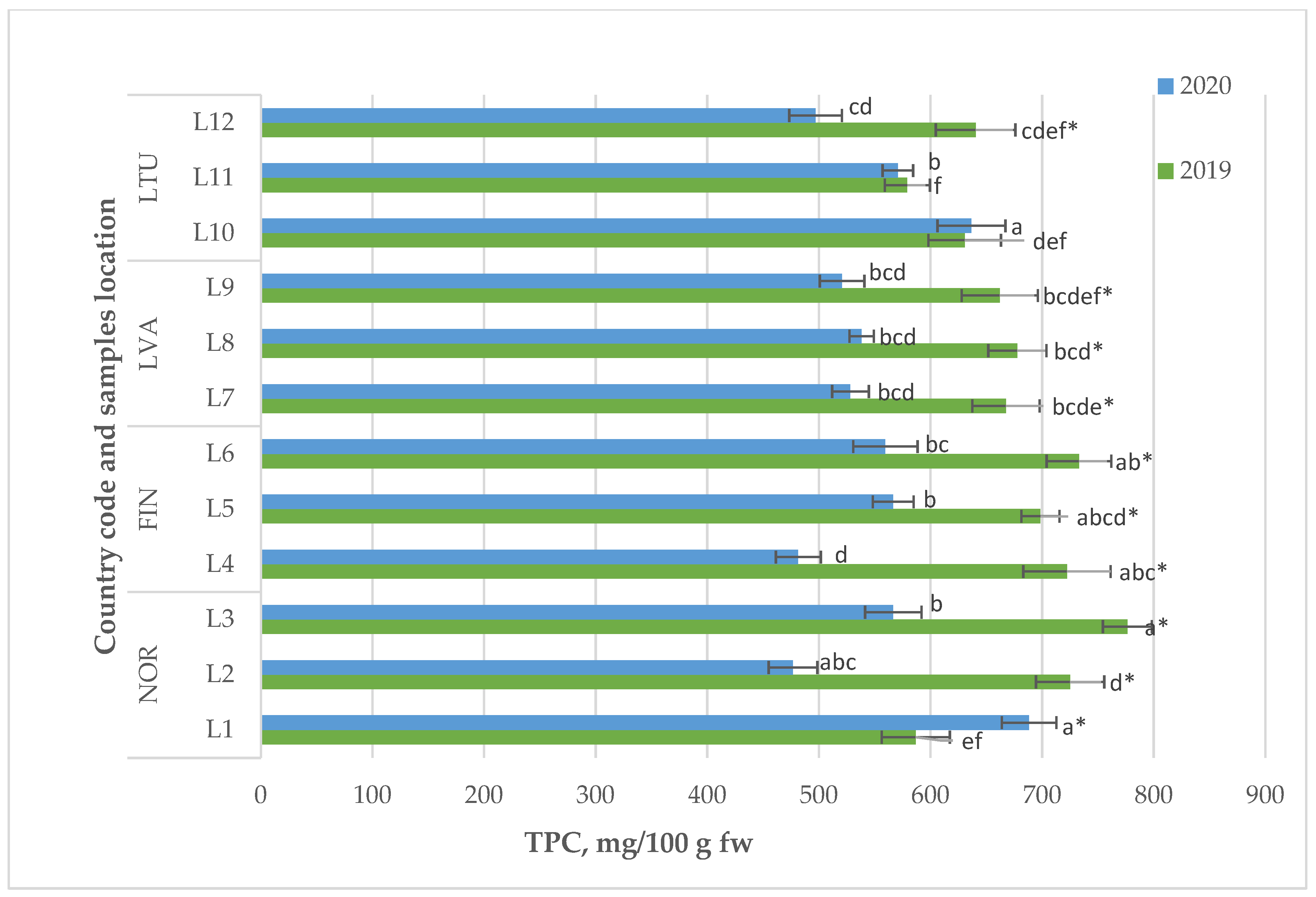
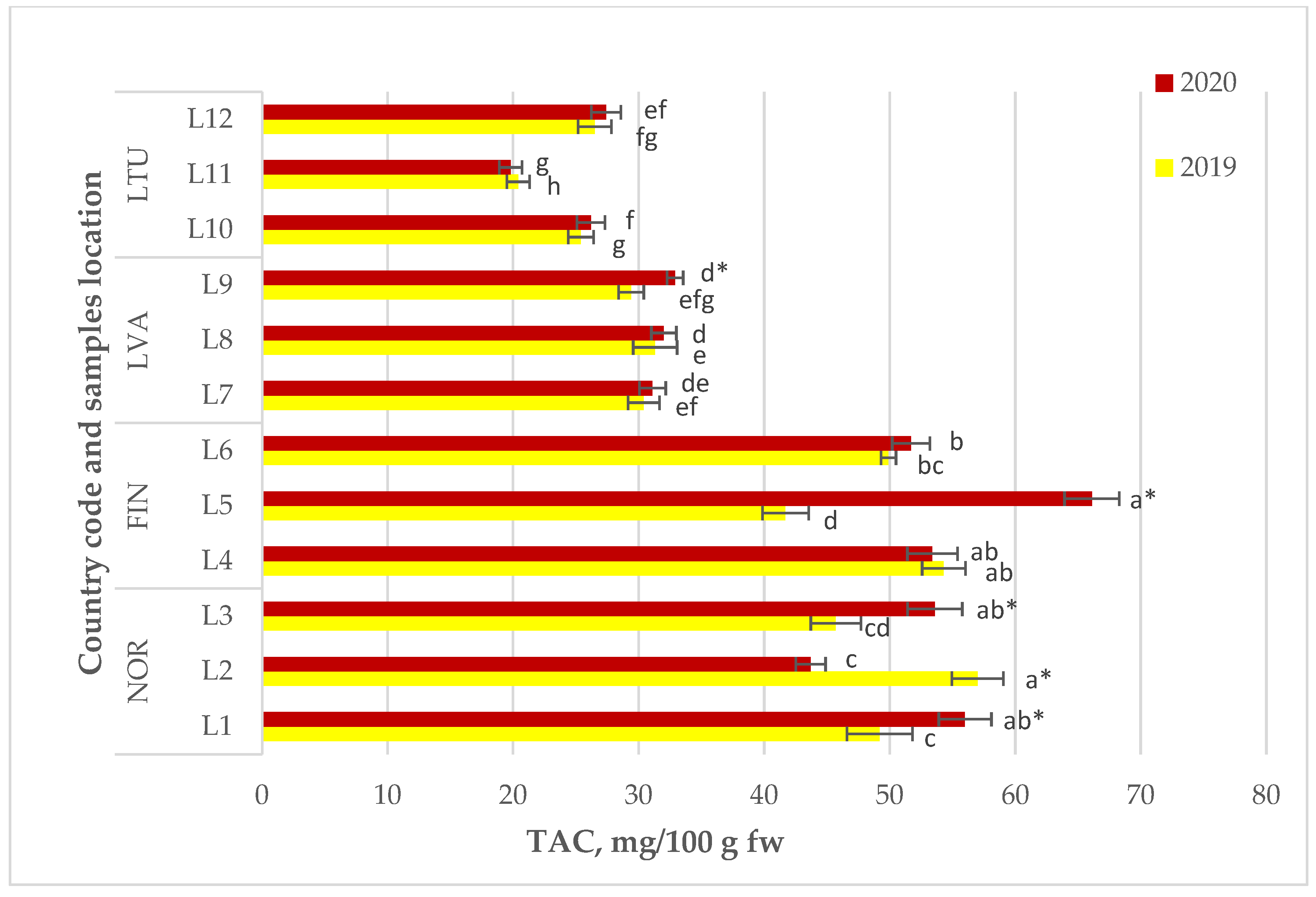
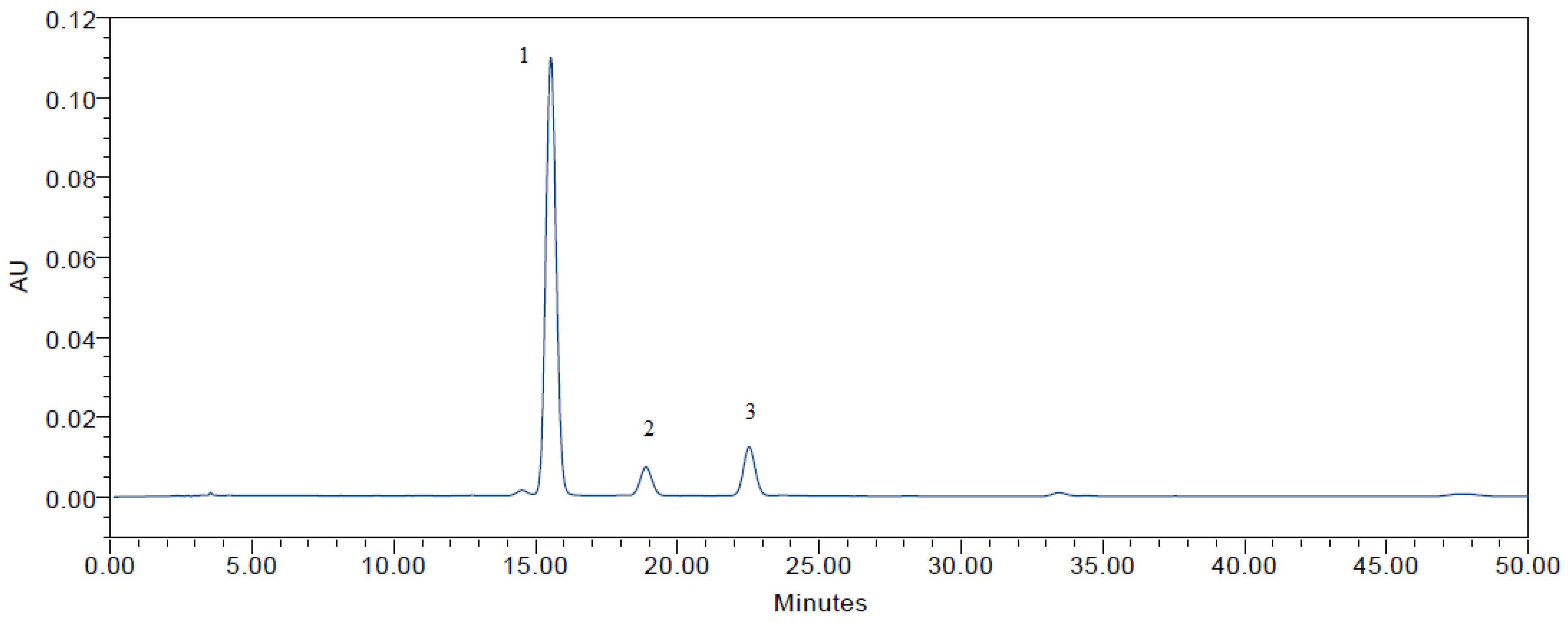
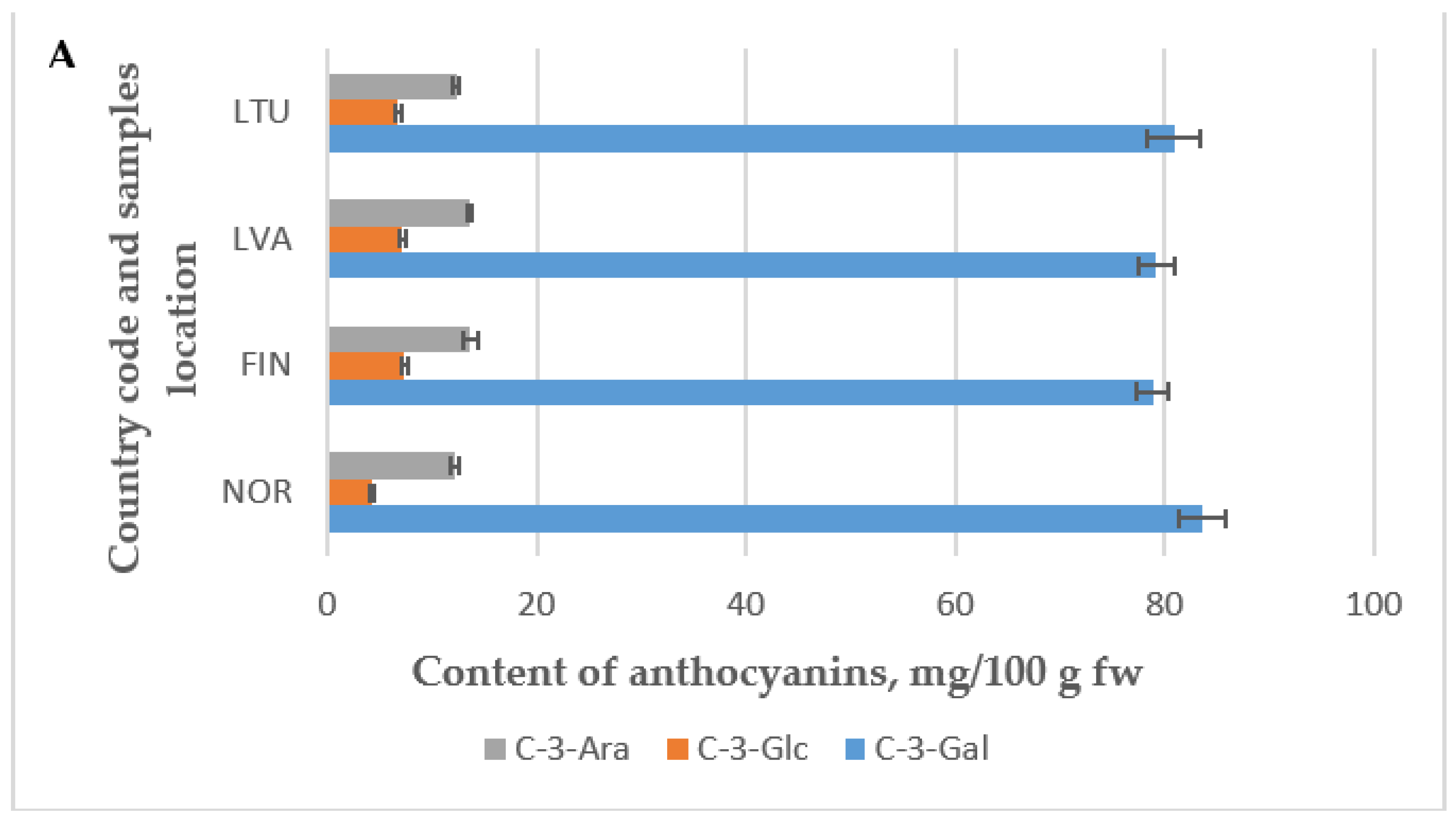
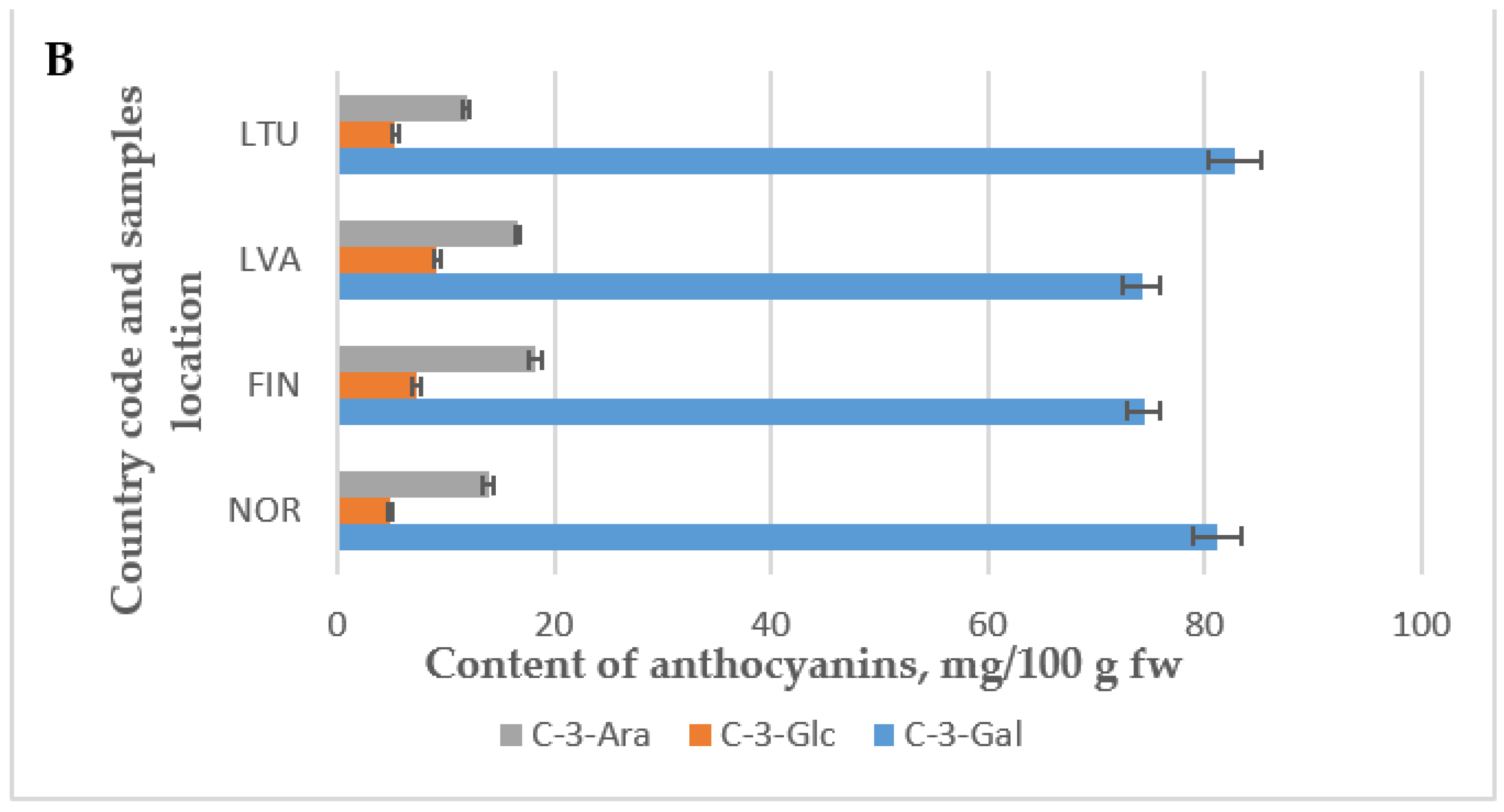
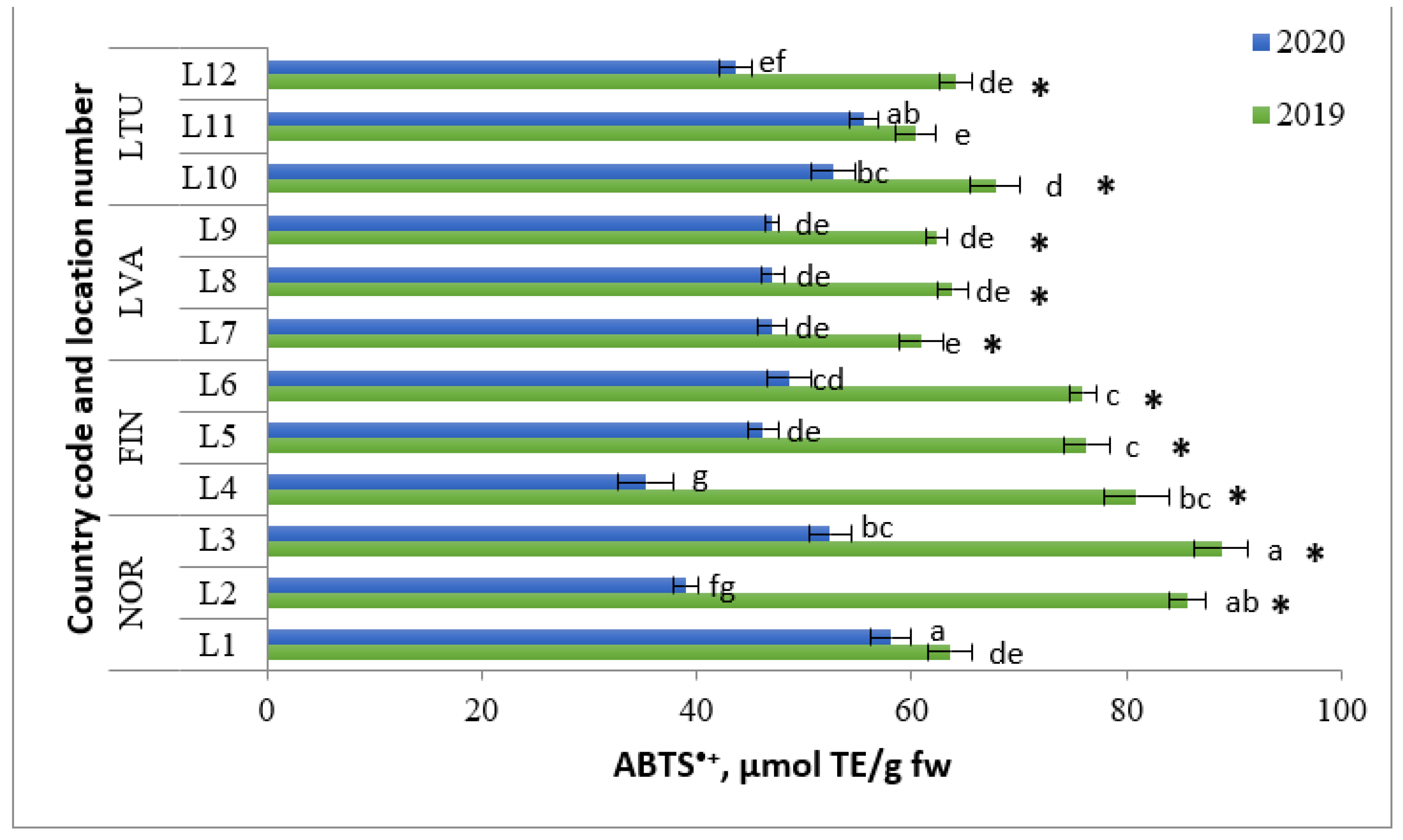


| Country Code | Location Name | Pro-Anthocyanidins, mg/100 g fw | |
|---|---|---|---|
| 2019 | 2020 | ||
| NOR | L1 | 141.3 ± 3.96 def | 149.0 ± 3.57 a |
| L2 | 180.6 ± 5.41 f | 196.8 ± 4.07 b | |
| L3 | 208.0 ± 6.45 a * | 191.8 ± 4.64 bc | |
| Mean | 161.0 ± 6.71 a | 179.2 ± 5.55 a * | |
| FIN | L4 | 213.1 ± 3.02 bc | 268.6 ± 2.58 g * |
| L5 | 189.2 ± 2.18 c * | 161.4 ± 1.48 de | |
| L6 | 182.8 ± 1.27 c | 215.4 ± 2.08 cd * | |
| Mean | 186.0 ± 3.12 a | 215.1 ± 6.41 a * | |
| LVA | L7 | 152.5 ± 2.01 e | 171.8 ± 1.40 de * |
| L8 | 153.1 ± 1.45 de | 168.9 ± 1.21 de | |
| L9 | 155.2 ± 1.10 de | 170.1 ± 0.58 de * | |
| Mean | 153.6 ± 1.82 b | 170.3 ± 0.91 a * | |
| LTU | L10 | 196.2 ± 2.34 d | 235.9 ± 0.58 de * |
| L11 | 159.5 ± 1.52 de | 212.4 ± 1.00 de * | |
| L12 | 200.7 ± 1.93 e | 200.1 ± 1.47 ef | |
| Mean | 159.5 ± 3.65 b | 216.1 ± 5.56 a * | |
| Country Code | Location Name | Vitamin C, mg/100 g fw | |
|---|---|---|---|
| 2019 | 2020 | ||
| NOR | L1 | 9.6 ± 0.28 | 9.2 ± 0.25 |
| L2 | 9.5 ± 0.41 | 8.8 ± 0.37 | |
| L3 | 9.5 ± 0.36 | 9.1 ± 0.19 | |
| Mean | 9.5 ± 0.09 | 9.0 ± 0.21 | |
| FIN | L4 | 9.2 ± 0.22 | 8.9 ± 2.58 |
| L5 | 9.6 ± 0.18 | 9.2 ± 1.48 | |
| L6 | 9.4 ± 0.27 | 9.1 ± 2.08 | |
| Mean | 9.4 ± 0.20 | 9.1 ± 0.15 | |
| LVA | L7 | 9.2 ± 0.20 | 8.8 ± 0.25 |
| L8 | 9.1 ± 0.35 | 8.9 ± 0.21 | |
| L9 | 9.0 ± 0.11 | 9.1 ± 0,28 | |
| Mean | 9.1 ± 0.10 | 8.8 ± 0.07 | |
| LTU | L10 | 9.2 ± 0.34 | 8.8 ± 0.18 |
| L11 | 9.2 ± 0.32 | 9.0 ± 0.31 | |
| L12 | 9.1 ± 0.18 | 8.9 ± 0.47 | |
| Mean | 8.9 ± 0.06 | 8.9 ± 0.10 | |
| Location Number | Country Code | Sample Coordinates | Province, Geographical Region |
|---|---|---|---|
| L1 | NOR (Norway) | Lat. 69° 41.665200′; Lon. 18° 41.244726′ | Hålogaland, Tromso distr. |
| L2 | NOR (Norway) | Lat. 69° 45.144144′; Lon. 19° 1.097034′ | Kvaloya, Tromso distr. |
| L3 | NOR (Norway) | Lat. 69° 43.550706′; Lon. 19° 7.144680′ | Knutsenkohen, distr. |
| L4 | FIN (Finland) | Lat. 65° 02.4578′; Lon. 25° 42.8869′ | Saviharju, Oulu reg. |
| L5 | FIN (Finland) | Lat. 65° 00.6398′; Lon. 26° 05.5423′ | Karahka, Oulu reg. |
| L6 | FIN (Finland) | Lat. 64° 54.3698′; Lon. 25° 44.6767′ | Hangaskangas, Oulu reg. |
| L7 | LVA (Latvia) | Lat. 56° 26.397300′; Lon. 22° 48.768360′ | Auce, Dobele distr. |
| L8 | LVA (Latvia) | Lat. 56° 26.426580′; Lon. 22° 49.528800′ | Auce, Dobele distr. |
| L9 | LVA (Latvia) | Lat. 56° 26.659200′; Lon. 22° 49.423800′ | Auce, Dobele distr. |
| L10 | LTU (Lithuania) | Lat: 54° 5.188333′; Lon. 24° 39.823333′ | Rudnia, Alytus distr. |
| L11 | LTU (Lithuania) | Lat: 54° 45.385000′; Lon. 23° 25.430000′ | Kazlu Ruda, Marijampole distr. |
| L12 | LTU (Lithuania) | Lat: 55° 5.091667′; Lon. 22° 27.851667′ | Viesvile, Jurbarkas distr. |
Disclaimer/Publisher’s Note: The statements, opinions and data contained in all publications are solely those of the individual author(s) and contributor(s) and not of MDPI and/or the editor(s). MDPI and/or the editor(s) disclaim responsibility for any injury to people or property resulting from any ideas, methods, instructions or products referred to in the content. |
© 2023 by the authors. Licensee MDPI, Basel, Switzerland. This article is an open access article distributed under the terms and conditions of the Creative Commons Attribution (CC BY) license (https://creativecommons.org/licenses/by/4.0/).
Share and Cite
Urbonaviciene, D.; Bobinaite, R.; Viskelis, P.; Viskelis, J.; Petruskevicius, A.; Puzeryte, V.; Cesoniene, L.; Daubaras, R.; Klavins, L.; Bobinas, C. Nutritional and Physicochemical Properties of Wild Lingonberry (Vaccinium vitis-idaea L.)—Effects of Geographic Origin. Molecules 2023, 28, 4589. https://doi.org/10.3390/molecules28124589
Urbonaviciene D, Bobinaite R, Viskelis P, Viskelis J, Petruskevicius A, Puzeryte V, Cesoniene L, Daubaras R, Klavins L, Bobinas C. Nutritional and Physicochemical Properties of Wild Lingonberry (Vaccinium vitis-idaea L.)—Effects of Geographic Origin. Molecules. 2023; 28(12):4589. https://doi.org/10.3390/molecules28124589
Chicago/Turabian StyleUrbonaviciene, Dalia, Ramune Bobinaite, Pranas Viskelis, Jonas Viskelis, Aistis Petruskevicius, Viktorija Puzeryte, Laima Cesoniene, Remigijus Daubaras, Linards Klavins, and Ceslovas Bobinas. 2023. "Nutritional and Physicochemical Properties of Wild Lingonberry (Vaccinium vitis-idaea L.)—Effects of Geographic Origin" Molecules 28, no. 12: 4589. https://doi.org/10.3390/molecules28124589
APA StyleUrbonaviciene, D., Bobinaite, R., Viskelis, P., Viskelis, J., Petruskevicius, A., Puzeryte, V., Cesoniene, L., Daubaras, R., Klavins, L., & Bobinas, C. (2023). Nutritional and Physicochemical Properties of Wild Lingonberry (Vaccinium vitis-idaea L.)—Effects of Geographic Origin. Molecules, 28(12), 4589. https://doi.org/10.3390/molecules28124589









